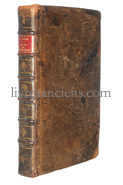

Incunabula and early printed books
9500 €
750 €
3500 €
500 €
950 €
1200 €
500 €
900 €
6000 €
2500 €
600 €
500 €
Sold
1250 €
800 €
2500 €
1500 €
33000 €
900 €
600 €
1300 €
2800 €
Sold
950 €
900 €
1800 €
Sold
1750 €
550 €
1500 €
European VAT number: FR87515091171
© Eric Zink, Antiquarian Bookseller










![Photo FIENUS, Thomas [FEYENS].](https://images.livresanciens.com/livres/203669/images/P3.jpg
)


![Photo [BIBLE].](https://images.livresanciens.com/livres/203631/images/P8.jpg
)
![Photo DION CASSIUS [Jean Xiphilin].](https://images.livresanciens.com/livres/203596/images/P1.jpg
)


![Photo LEON L'AFRICAIN [Leo Africanus, Johannes (al-Hasan ibn Muhammad al-Wazzan al-Fasi).].](https://images.livresanciens.com/livres/203247/images/P5.jpg
)


![Photo [BRISSON, Barnabé || HOTMAN, François || DUPRAT, Pardoux ].](https://images.livresanciens.com/livres/203084/images/P1.jpg
)
![Photo [CODE JUSTINIEN].](https://images.livresanciens.com/livres/203081/images/P4.jpg
)




![Photo [LIVRE d'HEURES ENLUMINÉ].](https://images.livresanciens.com/livres/200977/images/P15.jpg
)





![Photo HIPPOCRATE || [CORNARIUS, Janus].](https://images.livresanciens.com/livres/201468/images/P3.jpg
)





